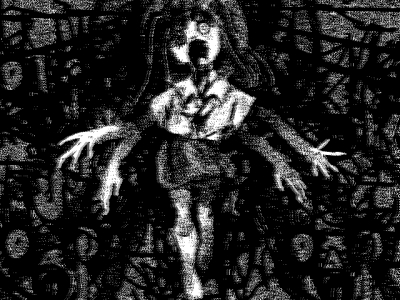 The internet has midwived a style of short horror story called the “creepypasta”. Where horror novels are MOABs and fusion bombs, creepypasta are IEDs, designed to be efficient, minimal, and easy to transport (ie, memetic). And if they fail to blow up, no matter. This was a surprise attack from the shadows. There will be another one tomorrow.
The internet has midwived a style of short horror story called the “creepypasta”. Where horror novels are MOABs and fusion bombs, creepypasta are IEDs, designed to be efficient, minimal, and easy to transport (ie, memetic). And if they fail to blow up, no matter. This was a surprise attack from the shadows. There will be another one tomorrow.
Creepypastas are bound by two rules: they must be posted anonymously, and everyone who reads them must play along with the idea that they are real. One of the more famous ones I’ve seen is called Killswitch, about a creepy videogame (a popular topic.) The author is Catherynne M Valente. Either that or she’s stealing someone’s story, because it’s found in her 2013 collection, The Melancholy of Mechagirl.
It’s not very good. But it’s the greatest kind of not very good story…the sort that’s interesting to talk and think about. Most copypastas are vapid and hollow, Ikea-assembled by teenagers using dull ideas from horror movies. Try to analyse them and your hand closes on empty air.
But Killswitch is interesting, at least. It’s kneecapped by the fact that so many of her descriptions of videogame playing seem “off” or wrong. I doubt she plays games much. Maybe she was motivated to write it by the relative mysteriousness or exoticism of gaming (the same way white kids in Cleveland are attracted to Japanese culture, I suppose, because it’s unlike what they’re used to), but what seems mysterious to an ingénue will not seem mysterious to someone “in the know”. It will seem dead, and artificial.
Old-school videogames are popular topics for creepypasta partly because they invoke nostalgia, and also because there’s much more room for “creepyness” in a 8-bit 460×360 game where everything is displayed in blocky pixels and your imagination has to do the rest. The “cow level” in Diablo is a good example. For years it was rumoured that the player could access a secret part of the game by clicking a cow or some such, and gamers used large amounts of electricity trying to do this.
But the details have to be right, or the artifice is exposed and the creepyness is gone. The trouble with Killswitch is that we get things like this:
On the surface it was a variant on the mystery or horror survival game, a precursor to the Myst and Silent Hill franchises. The narrative showed the complexity for which Karvina was known, though the graphics were monochrome, vague grey and white shapes against a black background.
The game described sounds totally different to Myst or Silent Hill, and if it’s a survival horror game, comparisons to Infogrames’ Alone in the Dark would seem more appropriate than a 1999 Playstation game.
Porto awakens in the dark with wounds in her elbows, confused.
How does the player know that Porto is confused? How can we see the wounds in her elbows when the game is black and white? Valente’s describing a movie here, not a game.
Killswitch, by design, deletes itself upon player completion of the game. It is not recoverable by any means, all trace of it is removed from the user’s computer. The game cannot be copied.
That’s HUGE. If a real game was discovered that could not be copied, nobody would give a shit about the story or the characters. It would be one of the biggest tech stories ever. The software industry would spend millions or billions trying to understand or decipher the copy protection – if would be their chance to stomp the windpipe of piracy forever. Karvina Corporation would be the industry’s fair-haired child. But Valente just throws that out there as a plot point. The game cannot be copied, here is a full and here is a stop.
At least tell us what happens when we try to copy or reverse engineer the game. Is there an error message? We want to be in the midst of this story but Valente’s inexperience is holding us away at arm’s length.
No Comments »
Comments are moderated and may take up to 24 hours to appear.
No comments yet.
